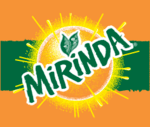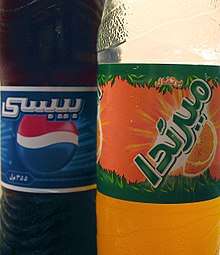Mirinda
 | |
| Type | Orange drink |
|---|---|
| Manufacturer | PepsiCo |
| Country of origin | Spain |
| Introduced | 1959 |
| Related products |
Fanta Pepsi Sunkist (soft drink) |
Mirinda is a brand of soft drink originally created in Spain in 1959 and now owned by PepsiCo with global distribution. Its name may come from Esperanto, meaning "admirable".[1]
It is available in fruit varieties including orange, citrus, grapefruit, apple, strawberry, raspberry, pineapple, pomegranate, banana, passionfruit, lemon, hibiscus, guarana, tangerine, pear, watermelon[2] and grape flavours as well as tamarind. It is part of a beverage area often referred to as the flavour segment, comprising carbonated and non-carbonated fruit-flavoured beverages. The orange flavour of Mirinda now represents the majority of Mirinda sales worldwide following a major repositioning of the brand towards that flavour in the early 1990s.
Mirinda has been owned by PepsiCo since 1970[3] and is primarily commercialized outside the United States. It competes with Coca-Cola's Fanta, Britvic's Tango and Dr Pepper's Orange Crush or Sunkist brands, with flavour brands localized to individual countries. As with most soft drinks, Mirinda is available in multiple formulations of flavour, carbonation and sweetener depending on the taste of individual markets.
History
Mirinda was originally produced in Spain. It became available in the United States in late 2003 in bilingual packaging, and initially sold at a reduced price, presumably to become a competitor against Coke's Fanta brand. Since 2005, Mirinda flavours have largely been sold under the Tropicana Twister Soda brand in the United States except in Guam, where Pepsi began selling it under the Mirinda brand in 2007 (replacing Chamorro Punch Orange). PepsiCo also tried to sell Mirinda in Brazil in late 1996, but the brand was discontinued in 1998 after weak sales, keeping the local brand Sukita under production. In Italy, it is sold under the brand Slam.
Advertising and recent events

Mirinda campaigns over the years have included the "Mirinda Woman" campaign in the 1970s. The "Mirinda Craver"" ads produced by Jim Henson from 1975 to 1978 involved a monster called the Mirinda Craver (performed by Bob Payne and voiced by Allen Swift) craving the Mirinda drinks and will do anything to obtain a Mirinda drink. With the Mirinda Craver being a live-hand Muppet, Bob Payne was assisted in performing the Mirinda Craver by Louise Gold, Dave Holman, or Faz Fazakas with either one handling one of the arms of the Mirinda Craver.
A campaign between 1994 and 1996 used the tag-line "The Taste is in Mirinda" with the Blue Man Group. In some markets, including Mexico, the Blue Man Group campaign re-launched Mirinda away from a multi-flavour positioning to a brand solely focused on the orange flavour. The Blue Man Group campaign showed the Blue Man Group competing to drink orange Mirinda and celebrating a successful drink with an open-mouth exclamation of 'Mirindaaaa'. Also in Mexico, Mirinda launched a campaign with the Pokémon anime series aimed at children with a promotion of gadgets with the characters of the manga series.
Mirinda advertising campaigns have been handled by Pepsi's stable of creative agencies, including BBDO and J. Walter Thompson.
Mirinda has good sales in India. It uses "Pagalpanti Bhi Zaruri Hai" ("Madness is also needed" in Hindi) as sales tagline while Indian actress Asin is the brand ambassador of Mirinda in India. It also launched the "Mirinda Pagalpanti League" campaign in India to connect youths around the nation and share their fun stories on TV commercials.[4] Coca-Cola's brand Fanta is the major competitor of Mirinda in the Indian markets. The most popular flavours of Mirinda in India include orange and lime.
Mirinda regularly introduces special movie-themed editions in Asia. Recent ones included Batman (blueberry) and Superman (fruit punch). Mirinda has also recently released a new flavour of drinks called Mirinda creme. They come in three flavours: mango, raspberry and lime.
Mirinda is no longer sold in New Zealand, replaced with the introduction of PepsiCo's new Mountain Dew range (code red, live wire, pitch black, electro shock & passionfruit frenzy) of similar flavours.
As of November 2016, Clendon New World and Countdown supermarkets were bringing back Mirinda with their two flavours raspberry and orange, but it was unknown whether this was only for a limited sale or a permanent official return.
Mirinda has a long history in many Arab Countries. It has been sold since the late 1970s. As in many other countries, Mirinda comes in different flavours. Gulf states and Egypt are the biggest markets for Mirinda.
Mirinda is also sold in France in Arab stores, Arab fast foods and also in some of the Large French Hypermarkets like Carrefour, Auchan and Geant etc. With flavours of apple, raspberry, pineapple, strawberry, red apple and orange either in little cans or in 2 liter bottles.
Production
Mirinda's primary formulation is as an artificially flavoured beverage. However, it has been produced in the past with a percentage of fruit juice, usually due to local tax benefits tied to non-artificial juice ingredients.
References
| Wikimedia Commons has media related to Mirinda. |
- ↑ Ellemberg, Enrique (23 January 2005). "89th Esperanto World Convention, Beijing, China. July 2004 (a01)". Archived from the original on 26 February 2005.
- ↑ MSL (3 September 2014). "A Chinese Mirinda -- 冰镇西瓜味". Omnilogy (Non-SEO and SEO) forum. Retrieved 24 July 2018.
- ↑ "Produktseite „Mirinda"" (in German). PepsiCo Deutschland. 2012. Archived from the original on 31 March 2012.
Mirinda kommt ursprünglich aus Spanien und wurde 1970 in das PepsiCo-Markenportfolio integriert. Für alle die es orangig-erfrischend lieben ist Mirinda der perfekte Durstlöscher. (Mirinda came originally from Spain and was integrated into the PepsiCo brand portfolio in 1970. For everyone who loves refreshing oranges, Mirinda is the perfect thirst quencher.)
- ↑ BestMediaInfo (12 March 2014). "Mirinda Gives A New Twist To 'Pagalpanti'". Business Insider India. Retrieved 8 April 2015.